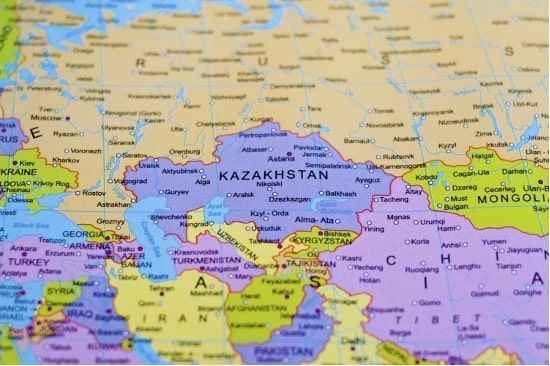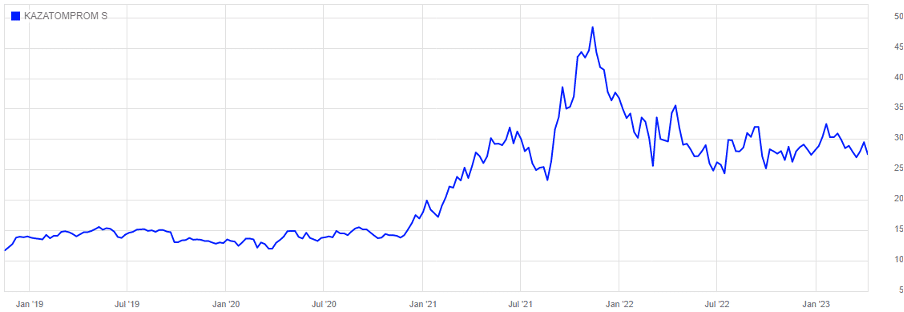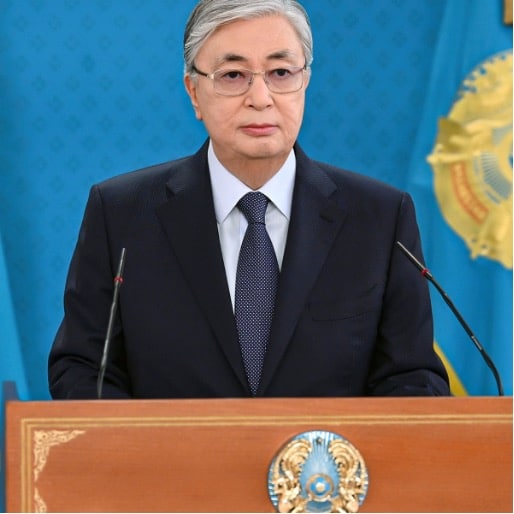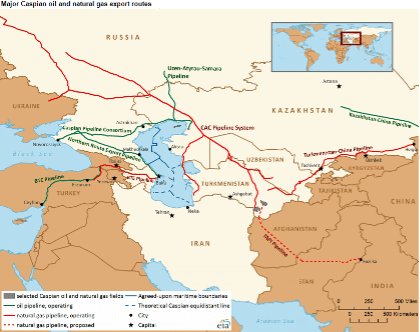The former Soviet state is toeing a delicate line between Russian politics, Chinese protections, and European energy concerns.

Uranium is in many ways like lithium.
It’s non-fungible, very reactive, and for many years was unprofitable to mine out of the ground. But with nuclear power becoming much more acceptable as a ‘green energy’ source, and the basic uranium investing fundamentals changing, now could be the time to invest in the best uranium stocks.

This is because — and this is only an opinion — the short-term bear market in uranium makes some of the most promising small-caps very appealing at current prices. Many quality projects are being depressed by the current uranium prices, but this is only a short-term problem.
Of course, like lithium, there is no way to directly buy the silvery-white metal. But there are a few workarounds, with differing merits.
Uranium price trading options
One popular investment choice is the Yellow Cake ETF which offers ‘direct exposure to the spot uranium price without exploration, development, mining or processing risk.’ The ETF has fallen by 23% over the past year but is still up 74% over the past five.
A second is the Global X Uranium ETF, which tracks both nuclear production companies and uranium miners, giving investors wide exposure to the entire supply chain — though this particular option has not performed well for investors either over the short or long term.
A third choice is to buy shares in blue-chip established uranium miners. The largest dedicated uranium miner is Canada’s Cameco, up 170% over the past five years. This is an excellent long-term choice; however, the shares have dipped over the past year, and I think there could be a further near-term correction when measuring the company’s fundamentals against the performance of peers.
Fourth, there’s the Geiger Counter investment company which invests heavily in uranium explorers. Shares are up over 100% over the past five years, but down 50% over the past 12 months. I don’t consider Geiger to be an excellent opportunity in itself, but it is a useful company to follow as it highlights small-cap explorers and miners that sometimes fly under the radar before taking off.
Kazatomprom shares: best high-risk uranium play?
For those who believe that uranium is now undervalued, there is one miner that could be set to benefit from a recovery more than any other — and that’s the majority-state-owned Kazakhstan uranium miner Kazatomprom (LON: KAP).
The miner is responsible for over 40% of the world’s primary uranium supply, and its uranium is used in nuclear reactors all over the world.

Closely following uranium’s price trajectory, KAP shares surged in late 2021, before falling back to circa $27.50 apiece today. While still up by 128% over the past five years, Kazakhstan’s uranium miner could be due a recovery closer to past highs in the near to mid-term.
Why is this?
Two issues dominate the stock’s price: the price of uranium, which I analyse will rise over the longer-term, and relations with Russia. Previously, Kazakhstan’s close ties to the ‘Motherland’ weren’t a particular problem — but the Russia’s invasion of Ukraine, and the subsequent international sanctions, have many investors rightly concerned that Kazakhstan could be caught in the economic crossfire.
Russia is Kazakhstan’s biggest trading partner, and the two countries share a massive 4,750-mile-long border. And it’s been accused of helping Russia circumvent sanctions in order to maintain trading ties.
However, sanctions against the country are looking increasingly unlikely. It has had to gently toe a delicate line; regularly calling for peace and refusing to outright condemn Russia — instead abstaining on key UN votes.
UK Foreign Minister James Cleverly — who visited the nation in March — has commended the country’s position on the war and has promised to help it develop oil and uranium supply routes that bypass its former spiritual ally.
Kazakhstan Instability
It’s a key part of geopolitics to understand that not everything is black and white. Kazakhstan’s political instability is a direct result of its poverty — the average worker earns the equivalent of just $739 per month.
The government cannot openly criticise Russia, even if it wants to, because it is utterly dependent on the trading partnership. The west knows this, and instead of applying sanctions that will only serve to drive it back into the arms of Putin, will instead help the former soviet state manoeuvre out of Russia’s sphere of influence.

Kazakh President Kassym-Jomart Tokayev took power in March 2019 after years of protests saw former President Nursultan Nazarbayev end his decades-long rule. However, the predecessor initially retained key positions such as chairmanship of the Kazakh Security Council, allowing him to continue a policy of appeasement towards Russia — after years of supporting the annexation of Crimea and Putin’s accusations of Neo-Nazism in Ukraine.
Nazarbayev even decided who the new Prime Minister would be, breaking years of precedent, and forced Tokayev to accept a power sharing agreement wherein the Security Council came first when making decisions on foreign policy.
But 2022’s ‘Bloody January’ saw this dual-power agreement come to an end when huge political unrest saw Tokayev force Nazarbayev out entirely by seizing chairmanship of the Security Council.
On 5 January 2022, Russia entered Kazakhstan as part of the Collective Security Treaty Organization’s efforts to stabilise Tokayev’s regime from an attempted coup attempted by pro-Nazarbayev governmental elements. After securing order, Tokayev issued a direct criticism of his predecessor and arrested prominent allies who took part in the attempted coup.
Russia’s forces left the country on 19 January, with Putin likely believing that he had secured a key ally in the run-up to his invasion of Ukraine in March. But Kazakhstan’s refusal to legitimise the war means that Putin has miscalculated — it’s worth noting that Kazakhstan was the first CSTO member-state to rule out sending troops to assist with the ‘special military operation.’
Putin had misunderstood the mood of the country. Tokayev had already decided to shift Kazakhstan from a Cyrillic alphabet to a Latin-based language in 2021 and had cancelled the country’s 2022 Victory Day in a clean break from former Soviet expectations.

Instead, Kazakhstan is turning to Europe and China.
China because the country’s uranium, oil, and deposits of Rare Earth Elements makes it a critical supplier of future raw materials needed in its Belt and Road Initiative. Bilateral security co-operation has greatly increased over the past year — with most analysts expecting that China will continue to dominate as the security guarantor of Central Asia. It’s well understood that Russia’s military could not currently help in the event of another uprising.
And Europe because the continent has now put energy security on the top of the political agenda. While gas may have fallen for now, next winter could see prices surge again — and the continent is quietly looking for more non-Russian supplies. It’s worth noting that Russia temporarily shut down the Caspian pipeline in July 2022 after Tokayev promised to increase oil output through the pipeline that cuts across Russia to Europe.
The pipeline is responsible for 1% of global and two-thirds of the country’s oil exports — and importantly, Russian oil is blended into the oil mix en-route — leaving it as an exception to current sanctions. Of course, these are paper-thin given that India is simply repackaging Russian oil for sale to the west.
But it’s key to note that the west is looking for ways to help the Kazakhs exit Russian influence rather than punish them for a geopolitical position over which they have no control.
None of this is commentary about Kazakhstan governance or ethics — simply a note about the fears that Kazakhstan uranium and oil could face sanctions — which may be overblown.
And as nuclear energy development continues, Kazatomprom could be a key beneficiary.
This article has been prepared for information purposes only by Charles Archer. It does not constitute advice, and no party accepts any liability for either accuracy or for investing decisions made using the information provided.
Further, it is not intended for distribution to, or use by, any person in any country or jurisdiction where such distribution or use would be contrary to local law or regulation.